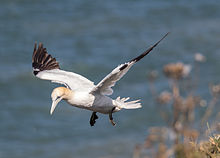Gannets
Gannets are the largest sea-bird we have here in the UK and can certainly handle themselves with their large size and dagger-sharp beaks… however during a trip last week we experienced an unusual encounter of one Gannet being repeatedly chased and harassed by a small flock of juvenile Gulls!(see our pictures)
Heavily cropped photos as this was happening quite the distance away from the boat (Ermol VI) but nevertheless, a pretty cool sighting and one crew/guide Sarah had never seen before. All Gulls and Gannet parted ways safely (eventually)
Gannets are seabirds comprising the genus Morus in the family Sulidae, closely related to boobies.
Northern gannets are the largest seabirds in the North Atlantic, having a wingspan of up to two metres (6+1⁄2 feet). The other two species occur in the temperate seas around southern Africa, southern Australia, and New Zealand
Etymology
“Gannet” is derived from Old English ganot meaning “strong or masculine”, ultimately from the same Old Germanic root as “gander”.[1]
Taxonomy
Morus is derived from Ancient Greek μωρός moros “stupid”[2] or “foolish” due to lack of fear shown by breeding gannets and boobies, allowing them to be easily killed.[3]
Hunting
Gannets hunt fish by diving into the sea from a height of 30 m (100 ft) and pursuing their prey underwater, and have a number of adaptations:
- They have no external nostrils; they are located inside the mouth, instead.
- They have air sacs in the face and chest under the skin, which act like bubble wrap, cushioning the impact with the water.
- The position of their eyes is far enough forward on the face for binocular vision, allowing them to judge distances accurately.
Gannets can achieve speeds of 100 km/h (60 mph) as they strike the water, enabling them to catch fish at a much greater depth than most airborne birds.
The gannet’s supposed capacity for eating large quantities of fish has led to “gannet” becoming a description of somebody with a voracious appetite.
Mating and nesting
A northern gannet in Bonaventure Island‘s colony
Gannets are colonial breeders on islands and coasts, normally laying one chalky-blue egg. They lack brood patches and use their webbed feet to warm the eggs.[4] They reach maturity around 5 years of age. First-year birds are completely black, and subsequent subadult plumages show increasing amounts of white.
Northern gannets
The most important nesting ground for northern gannets is the United Kingdom, with about two-thirds of the world’s population. These live mainly in Scotland, including the Shetland Isles. The rest of the world’s northern-gannet population nests in Canada, Ireland, the Faroe Islands, and Iceland, with small numbers in France (they are often seen in the Bay of Biscay), the Channel Islands, Norway, and a single colony in Germany on Heligoland. The biggest northern-gannet colony is on Scotland’s Bass Rock in the Firth of Forth; in 2014, this colony contained some 75,000 pairs.[5] Sulasgeir off the coast of the Isle of Lewis, St. Kilda, Grassholm in Pembrokeshire, Bempton Cliffs in the East Riding of Yorkshire, Sceilig Bheag, Ireland, and Bonaventure Island, Quebec, are also important northern-gannet breeding sites.
Info: Wikipedia


